How to Create a Multiaxis Parallel to Surface Feature
Introduction
This tutorial explains how to create a Parallel to Surface feature. The feature uses a leading surface that is adjacent to the drive surface and creates a toolpath of parallel offsets from the leading surface, on the selected drive surface.
Example File
The SolidWorks part file for this tutorial is available for download at: http://www.bobcad.com/helpfiles. If you are connected to the Internet, you can click the link provided to download and save the Parallel to Surface Example 1.SLDPRT zip file. After extracting the zip file, you can then open the example file to use with this tutorial. In the example file provided, the stock and Machine Setup are already defined for the part. The part is simulated using the BC Table-Table machine.
In this example, you learn how to create a toolpath of parallel cuts on a surface using an adjacent surface edge to define the path. A side-tilt angle is applied to show you how to change the default tool orientation. You also learn how to create a margin to offset the tool from the adjacent surface. How to add a gouge check is also explained.

Part 1) Add the Feature
-
In the Property Manager, click the CAM Tree tab.
-
Right-click
 Machine
Setup and click Mill Multiaxis.
Machine
Setup and click Mill Multiaxis. -
In the Multiaxis Wizard, select Surface and click Parallel to Surface.
-
Click Next>> to go to the Posting dialog box.
Part 2) Define the Posting Parameters
-
The Work Offset # is automatically set to the value defined in the Machine Setup dialog box.
You can change the value here to update the Work Offset # for the feature. -
Click Next>> to go to the Multiaxis Posting dialog box.
Part 3) Define the Multiaxis Posting Parameters
-
Notice, at the top of the dialog box, that the Use Machine Settings check box is selected.
This means that the Multiaxis Posting parameters for the feature use the same parameters as the machine that is selected in Current Settings.
You can clear the Use Machine Settings check box to define the Multiaxis Posting parameters of the feature separately from the current machine settings.
For this example, no changes are needed. -
Click Next>> to go to the Tool page.
Part 4) Define the Tool Parameters
-
Clear the
 System
Tool check box.
System
Tool check box.
Set the Diameter to 0.50 and the Flute Length to 3.00.
Set the Corner Radius to 0.25 and the Overall Length to 5.00. -
Click Next>> to go to the Parameters dialog box.
Part 5) Select Geometry
-
To define the lead surface, in the Surface Paths tab, in the Pattern group, click Single Edge.
-
In the graphics area, select the two surfaces as shown next.

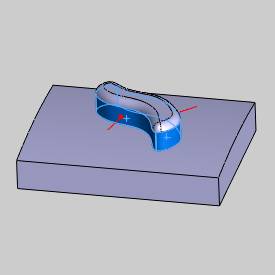
-
To accept the selections, click
 OK.
OK. -
To define the surface being machined, in the Multiaxis Wizard, click Drive Surfaces.
In the graphics area, select the drive surface as shown next.
-
To accept the selections, click
 OK.
OK.
The geometry selections for the feature are complete.
Part 6) Define the Parameters
-
In the Area group, next to Type, select Determined by Number of Cuts.
In the Number of Cuts box, type 6.00. -
In the Sorting group, next to Cutting Method, select One Way.
Next to Direction for One Way Machining, select Climb. -
In the Stepover group, next to Maximum Stepover, type 0.100.
-
At the top of the dialog box, click Link.
Near the bottom of the dialog box, click Retracts.
In the Clearance Area group, confirm that the Type is set to Plane, with the Direction set to Z Axis.
Confirm that the Height is set to 5.000.
This value is automatically set based on the Clearance Plane value from the Machine Setup dialog box. The value from the Machine Setup is only automatically set for the feature when you create the feature. Once the feature is created, you can edit the clearance plane value for the feature in this location (changing the value in the Machine Setup does not update existing Multiaxis features).
Click OKto close the Clearance Area dialog box.
-
To create a toolpath with the current settings, at the bottom of the dialog box, click Compute.
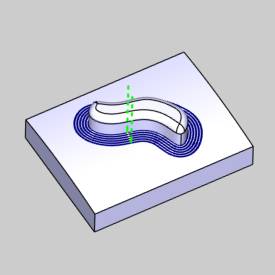
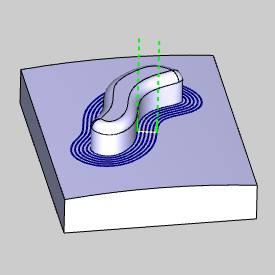
Notice the toolpath at the edge of the island. You can see that this will cut into the island in the middle of the part because the first toolpath pass is at the exact edge where the two surfaces meet.
A Margin must be defined.
Part 7) Edit the Feature and Define a Margin
-
When you computed the toolpath, the
 Multiaxis feature was added to the
CAM Tree.
Multiaxis feature was added to the
CAM Tree.
To edit the feature, right-click FeatureMultiaxis, and click Edit.
FeatureMultiaxis, and click Edit.
The Multiaxis Wizard displays. -
On the left side of the dialog box, click Parameters.
-
In the Area group, next to Type, click Margins.
The Margins dialog box displays. -
In the Start Margins box, type the radius of the tool which is 0.250.
(For this example, you could select the Add Internal Tool Radius check box instead of typing the value in the Start Margins box. Either method provides the same result.) -
To accept the changes and close the dialog box, click OK.
-
To add the change to the feature, click Compute.
The margin between the surfaces is applied as shown next.
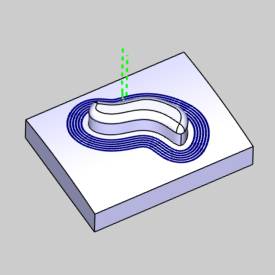

Part 8) Simulation
-
The next step is to simulate the program to look for any necessary changes.
In the BobCAM menu, click Simulation.
Simulation.
For help with simulation, view Getting Started with Simulation. -
During Simulation, it is shown that the tool axis is always normal to the selected drive surface.
The next step is to add a side tilt angle.
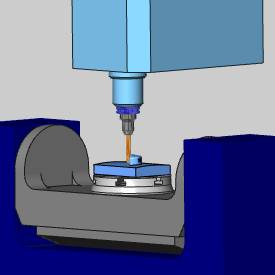
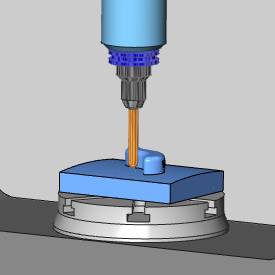
When the simulation is finished, click ![]() Exit Simulation.
Exit Simulation.
Part 9) Define the Side Tilt Angle
-
Right-click
 FeatureMultiaxis, and click Edit.
FeatureMultiaxis, and click Edit. -
On the left side of the Multiaxis Wizard, click Parameters.
-
At the top of the dialog box, click Tool Axis Control.
-
Next to Tool Axis Will, confirm that Tilted Relative to Cutting Direction is selected.
-
Next to Tilt Angle at Side of Cutting Direction, type a value of 20.00.
-
To add the change to the feature, at the bottom of the Multiaxis Wizard, click Compute.
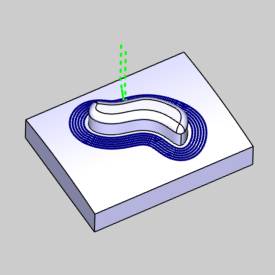
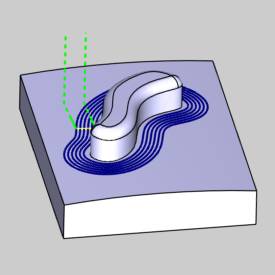
-
You can see that the side tilt angle has been applied by observing the direction of the plunge (exit and entry) moves (shown in green in the previous image).
To view the result, simulate the program.
You can see that a 20 degree side tilt angle is added to the tool axis orientation.
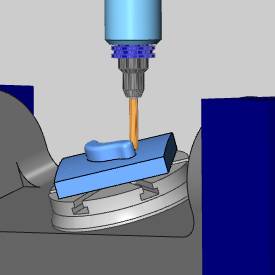
Part 10) Create a Gouge Check
-
For the last step of this tutorial, a gouge check is added to the feature.
Edit the feature. -
In the Multiaxis Wizard, click Parameters.
At the top of the dialog box, click Gouge Check. -
On the left side, in the Status column, select the
 check box above 1.
check box above 1.
In the Check column, select the check box for the Flute and the
Flute and the  Shaft.
Shaft.
In the Strategy and Parameters column, select TiltTool.
Below Tilt Tool, select Use Side Tilt Angle. -
To define the check surfaces, in the Geometry column, with both check boxes selected, click
 .
.
In the graphics area select all of the island surfaces in the middle of the part, as shown next.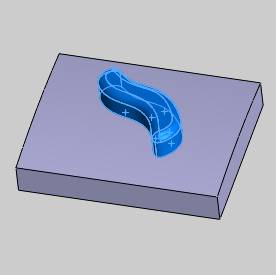
To accept the selections, click OK.
OK. -
To add the gouge check to the feature, click Compute.
If any gouges are found, an additional tilt angle is applied to the tool orientation until the feature is no longer gouging.
In this example, no further gouges are found.
This concludes the tutorial.
